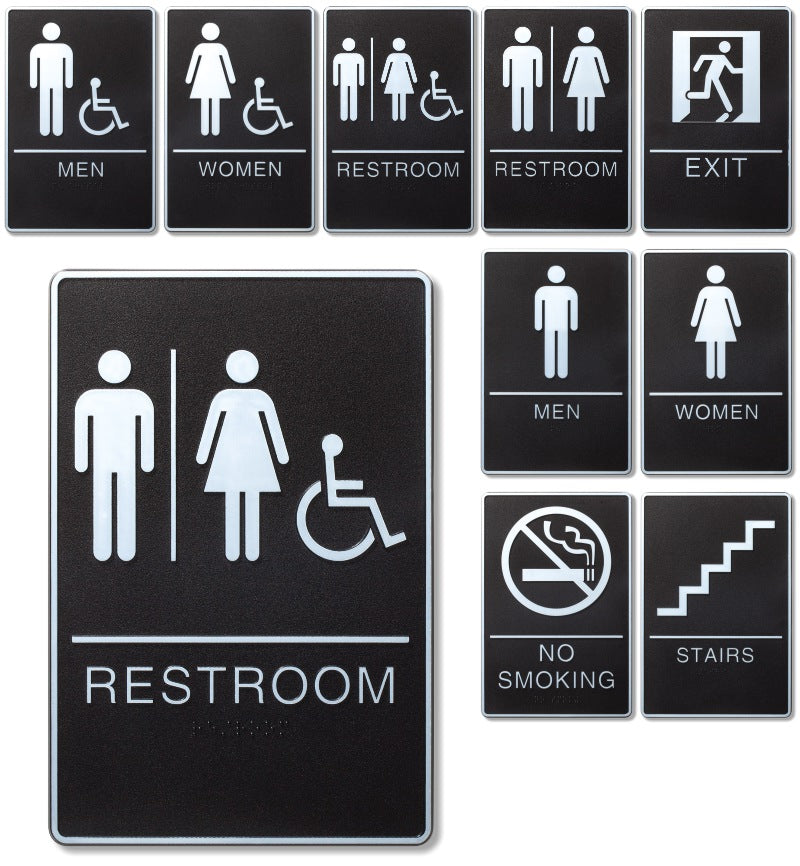Exactly How ADA Signs Improve Access for Everyone
Discovering the Trick Attributes of ADA Indicators for Boosted Accessibility
In the world of availability, ADA signs offer as quiet yet effective allies, ensuring that areas are comprehensive and navigable for people with disabilities. By incorporating Braille and tactile aspects, these signs break obstacles for the visually damaged, while high-contrast shade systems and clear typefaces provide to diverse visual requirements.
Significance of ADA Conformity
Making certain compliance with the Americans with Disabilities Act (ADA) is critical for promoting inclusivity and equivalent access in public areas and offices. The ADA, enacted in 1990, mandates that all public facilities, employers, and transport solutions suit individuals with disabilities, ensuring they take pleasure in the very same rights and chances as others. Compliance with ADA requirements not just meets lawful obligations however likewise improves a company's online reputation by showing its commitment to variety and inclusivity.
One of the crucial elements of ADA compliance is the execution of accessible signs. ADA indications are made to make sure that individuals with disabilities can conveniently browse with areas and buildings.
Furthermore, adhering to ADA laws can minimize the danger of possible fines and lawful effects. Organizations that stop working to comply with ADA guidelines might deal with claims or charges, which can be both damaging and economically challenging to their public image. Hence, ADA compliance is indispensable to promoting an equitable environment for everybody.
Braille and Tactile Elements
The incorporation of Braille and tactile aspects right into ADA signs personifies the concepts of accessibility and inclusivity. It is usually positioned under the corresponding text on signage to guarantee that people can access the details without aesthetic aid.
Tactile aspects prolong beyond Braille and include raised icons and personalities. These elements are created to be discernible by touch, allowing individuals to recognize area numbers, bathrooms, departures, and other vital areas. The ADA sets certain standards relating to the dimension, spacing, and positioning of these tactile components to maximize readability and guarantee consistency throughout various atmospheres.

High-Contrast Color Design
High-contrast color pattern play a critical role in boosting the visibility and readability of ADA signs for individuals with aesthetic disabilities. These schemes are crucial as they maximize the distinction in light reflectance between message and background, making sure that signs are conveniently discernible, also from a distance. The Americans with Disabilities Act (ADA) mandates using particular shade contrasts to fit those with minimal vision, making it a critical element of conformity.
The effectiveness of high-contrast colors exists in their ability to stick out in various illumination problems, including poorly lit atmospheres and areas with glow. Typically, dark text on a light background or light text on a dark history is utilized to attain optimal contrast. As an example, black message on a white or yellow history go to this website provides a stark aesthetic distinction that aids in quick acknowledgment and understanding.

Legible Fonts and Text Dimension
When taking into consideration the design of ADA signage, the choice of clear font styles and proper message dimension can not be overemphasized. These components are crucial for ensuring that signs come to individuals with visual disabilities. The Americans with Disabilities Act (ADA) mandates that font styles should be not italic and sans-serif, oblique, manuscript, extremely ornamental, or of unusual form. These requirements help guarantee that the text is easily readable from a distance and that the personalities are distinct to varied audiences.
According to ADA standards, the minimum message height should be 5/8 inch, and it must increase proportionally with watching distance. Uniformity in text dimension contributes to a cohesive visual experience, assisting individuals in browsing environments successfully.
Additionally, spacing in between letters and lines is indispensable to clarity. Ample spacing avoids personalities from appearing crowded, boosting readability. By adhering to these requirements, developers can considerably boost ease of access, making certain that signage serves its desired purpose for all individuals, no matter their visual abilities.
Reliable Positioning Techniques
Strategic positioning of ADA signage is necessary for taking full advantage of access and guaranteeing conformity with lawful criteria. Correctly positioned indications direct individuals with specials needs successfully, helping with navigating in public spaces. Secret factors to consider consist of closeness, elevation, and presence. ADA guidelines stipulate that signs ought to be installed at a height between 48 to 60 inches from the ground to ensure they are within the line of sight for both standing and seated individuals. This conventional height variety is important for inclusivity, try this making it possible for mobility device individuals and individuals of varying heights to access information effortlessly.
Additionally, indications pop over to this site have to be placed adjacent to the latch side of doors to enable simple identification prior to entry. Uniformity in sign positioning throughout a facility boosts predictability, decreasing confusion and boosting overall customer experience.

Final Thought
ADA indicators play a crucial function in advertising accessibility by incorporating attributes that address the demands of people with handicaps. These components jointly promote an inclusive environment, underscoring the importance of ADA compliance in making certain equivalent gain access to for all.
In the realm of ease of access, ADA signs serve as quiet yet effective allies, guaranteeing that spaces are comprehensive and navigable for people with handicaps. The ADA, established in 1990, mandates that all public facilities, employers, and transport solutions accommodate people with handicaps, ensuring they enjoy the very same rights and possibilities as others. ADA Signs. ADA indications are developed to ensure that people with impairments can easily browse with spaces and structures. ADA guidelines specify that indications should be placed at a height between 48 to 60 inches from the ground to ensure they are within the line of view for both standing and seated individuals.ADA signs play a crucial role in advertising ease of access by incorporating functions that address the demands of individuals with handicaps